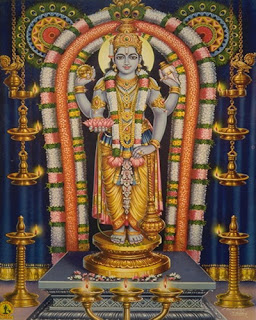Guruvayur (Malayalam: ഗുരുവായൂർ, Sanskrit: गुरुवायुपुरम्, Guruvāyupuram), also written
as Guruvayoor or Gurupavanapuri, is a municipal town inThrissur District, of Kerala State in India. It houses the famous Guruvayur Sree Krishna Temple, the fourth biggest temple in India in terms of the number of
devotees per day.
History
Guruvayur,
according to the legends may be 5,000 years old as the Guruvayur
temple idol
is. There are no historical records to establish it. In the 14th century, Tamil literature 'Kokasandesam',
references about a place called Kuruvayur is made. As early as 16th century,
many references are seen about Kuruvayur. In ancient Dravidic, Kuruvai means
sea, hence the village on the coast may be called Kuruvayur. According to
eminent historian Professor K. V. Krishna Iyer, the Brahmins had begun to come and settle
at Kodungallur during the period of Chandra
Gupta Maurya (321-297 BC).
Guruvayur
was a subordinate shrine of Trikkunavay Shiva temple before the latter was
destroyed by the Dutch in 1755. Trikkunavay in the Guruvayur documents is the
same as Thrikkanamathilakam or Mathilakam mentioned in the Dutch and British records. And this place was in
between Guruvayur and Kodungallur. The story of Pandyan King building a shrine here may be a
reference to the Azhavars, but they are all silent in their writing about
Guruvayur. It was Melpathur Narayana Bhattathiri's Narayaniyam through which the Guruvayur
temple got
famous all over India.
As
of the Indian census of 2001, Guruvayur had a
population of 21,187. Males constitute 46% of the population and females 54%.
Guruvayur has an average literacy rate of 85%, higher than the national average
of 59.5%: male literacy is 86%, and female literacy is 85%. In Guruvayoor, 10%
of the population is under 10 years of age.
Government
Guruvayoor
Township was formed on January 26, 1962 with four electoral wards with an area
of 6.49 km2. Later the wards were increased to 10 and in 1994
to 20 when the township was upgraded to Municipality status with an area of
29.66 km2. In 2010, the electoral wards were increased to 43.
Guruvayoor is a Grade-1 Municipality. The Municipality has a total population
of 20,216 with a population density of 31, 14 per km2. Guruvayoor
assembly constituency is part of Trichur (Lok Sabha constituency).
Festivals
Guruvayur Ekadasi
Ekadasi, the eleventh day of every lunar
fortnight, is very auspicious to the Hindus. Of the 24 Ekadasis in a year, the Vrishchika Ekadasi (Sukla paksha)
has got special significance in Guruvayur temple. A memorial honour for Gajarajan Kesavan is conducted in
Guruvayur. The Karanavar or head of the elephant family places a wreath at the
statue of Kesavan in front of Sreevalsam guest house and all the other
elephants stand around and pay obeisance. On Ekadasi day, the Udayasthamana
Pooja (dawn to dusk pooja) is conducted by the Devaswom itself . After the
morning seeveli, on Ekadasi there is a grand elephant procession to the
Parthasarathi temple since it is regarded as Geethopadesam Day also. On Ekadasi
after night pooja, the famous Ekadasi Vilakku with elephant procession takes
place and provides a fitting finale to the festival.
Chembai Sangeetholsavam
Chembai Sangeetholsavam is an annual Carnatic music festival held in Guruvayur by the Guruvayur
Devaswom at Thiruvaiyaru as a kind of homage to Chembai Vaidyanatha Bhagavatar, one of
the titans of Carnatic Classical Music. Chembai had conducted the festival in
the temple town on his own for about 60 years. He used to invite all the great
Carnatic Musicians to perform in the temple town and in course of time, the
scale of the festival rivalled the Thiruvaiyaru Thyagaraja Aradhana, which is
recognised as one of the most important festivals of homage paid to Saint
Thyagaraja.
The Guruvayur
Devaswom decided
to take charge after his death in 1974, and renamed it as Chembai
Sangeetholsavam in his memory. About 2000-2500 musicians participate in this
festival every year, and it is held for about 12–15 days culminating on
the Guruvayur
Ekadasi day,
when all the musicians sing 5 favourite songs of Chembai and also the Pancharatna
Kritis of
Thyagaraja.


No comments:
Post a Comment